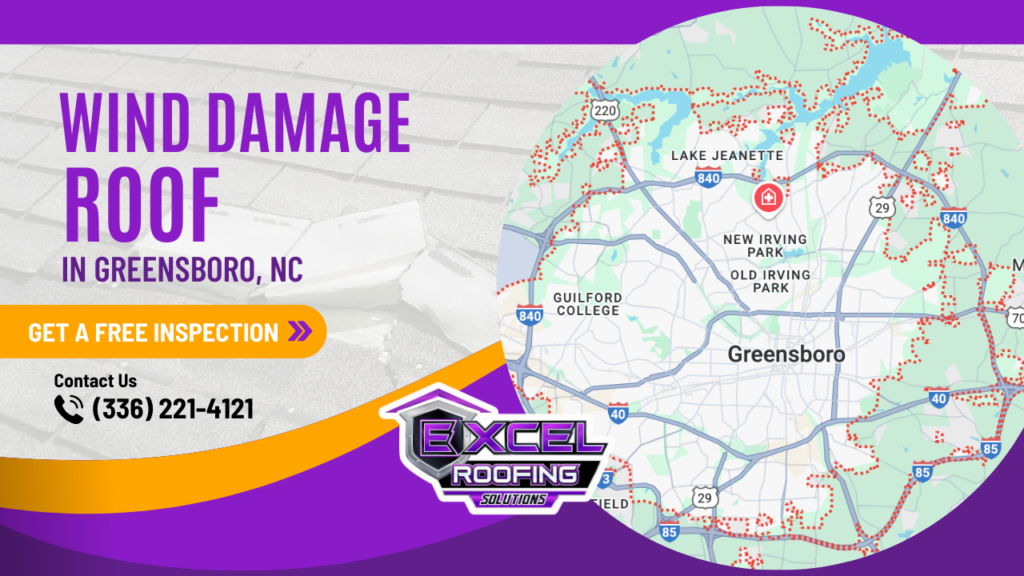Wind damage is one of the most common and costly issues homeowners face when it comes to roof maintenance, especially in a place like Greensboro, NC, where the weather can be unpredictable. Whether it’s a passing storm or a more severe weather event, strong winds can cause significant harm to your roof. Understanding how to deal with wind damage is important to protecting your home and avoiding expensive repairs. Here’s what you need to know.
1. Understanding Wind Damage
Wind can affect your roof in various ways, from minor shingle displacement to severe structural damage. The extent of the damage often depends on the wind’s speed, the roof’s condition, and the type of roofing materials used.
- Shingle Damage: One of the most common issues is lifting or missing shingles. High winds can get underneath the edges of shingles, loosening or tearing them off completely. This leaves your roof vulnerable to leaks and further damage.
- Flashing and Gutter Damage: Wind can also damage roof flashing (the metal used to seal areas like chimneys and vents) and gutters. Flashing that is bent or pulled away can lead to water seepage, while damaged gutters can cause improper drainage and potential water buildup on your roof.v
- Fallen Debris: High winds often bring down branches, trees, or other debris that can impact your roof, causing punctures, cracks, or other structural damage.
2. Signs of Wind Damage to Look For
After a windstorm, it’s important to inspect your roof for damage as soon as it’s safe. Here’s what you should be on the lookout for:
- Visible Shingle Loss: Check for any missing, curled, or torn shingles. Even if only a few are damaged, it’s crucial to address them quickly to prevent further issues.
- Damaged Flashing or Gutters: Inspect the areas around your chimney, vents, and skylights for loose or bent flashing. Also, check your gutters for any signs of detachment or bending.
- Debris on the Roof: Any debris on your roof, such as branches or leaves, should be removed promptly. Even small debris can cause significant damage over time if left unattended.
3. Immediate Steps to Take After Wind Damage
If you suspect your roof has been damaged by wind, taking quick action can help minimize the impact and prevent further issues.
- Document the Damage: Take photos of any visible damage to your roof, gutters, and surrounding areas. This documentation will be essential if you need to file an insurance claim.
- Make Temporary Repairs: If possible, make temporary repairs to prevent water from entering your home. For example, cover any exposed areas with a tarp until a professional can assess the damage.
- Contact Your Insurance Company: Notify your insurance company as soon as possible to start the claims process. Provide them with the documentation you’ve collected, and keep track of any communications or expenses related to the damage.
4. When to Call a Professional
While it might be tempting to handle roof repairs on your own, wind damage often requires professional expertise. Here’s when you should call in the pros:
- Extensive Damage: If a large portion of your roof is affected, or if there’s structural damage, it’s best to leave the repairs to a professional. We have the experience and equipment needed to safely and effectively restore your roof.
- Hidden Damage: Not all wind damage is visible from the ground. A professional roofing contractor like Excel Roofing Solutions can conduct a thorough inspection to identify hidden issues, such as leaks or weakened areas that could lead to problems down the road.
- Insurance Claims: Navigating the insurance claims process can be challenging. At Excel Roofing Solutions we can help provide the necessary documentation and even work directly with your insurance company to ensure you get the coverage you deserve.
5. Preventing Future Wind Damage
While you can’t control the weather, there are steps you can take to reduce the risk of wind damage to your roof:
- Regular Maintenance: Keep your roof in good condition with regular inspections and maintenance. Replace any missing or damaged shingles promptly, and ensure that your gutters and flashing are secure.
- Trim Trees: Keep trees and branches trimmed away from your roof. This helps reduce the risk of debris falling and causing damage during a storm.
- Upgrade Materials: If you’re in an area prone to high winds, consider upgrading to more durable roofing materials, such as impact-resistant shingles, that are designed to withstand strong winds.
Contact Excel Roofing Solutions Today!
Wind damage to your roof in Greensboro, NC, is a serious concern that requires prompt attention. By understanding the signs of damage and taking the appropriate steps, you can protect your home from further harm and avoid costly repairs. If you’re ever in doubt, don’t hesitate to reach out to a professional roofing contractor like Excel Roofing Solutions. We’re here to help you keep your roof—and your home—safe and secure, no matter what the weather brings.



